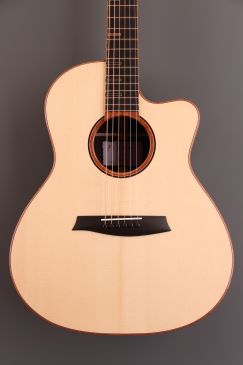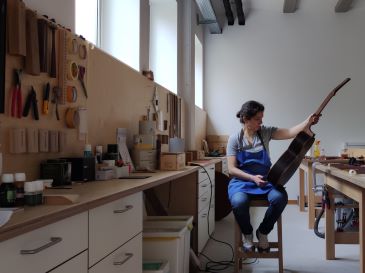Wood has fascinated Noemi Schembri since adolescence, about the same time she picked up playing the guitar. Her interests collided, sparking a curiosity about how the wooden instrument was built.
Inspired, the San Cataldo, Sicily native, moved to Canada, where she studied under the guidance of renowned Master Luthier Sergei De Jonge. Noemi had the opportunity to learn modern building techniques for both steel-string and classical guitars.
It was a new way of looking at her favorite instrument, which inspired her, after her apprenticeship, to return to Italy, where she opened her first workshop in Solighetto. She has since moved production to a larger space in Susegana, where she builds guitars entirely based on customer needs: desired sound, wood choice, ergonomics, playability, and aesthetics.
Noemi shared with me her journey and approach to lutherie, materials she uses, challenges she's faced, and more.
What inspired you to pursue guitar-building?
It was mainly the combination of my love for wood and woodworking and the fact that I started playing the guitar when I was 11. Over time, thanks to scholarly studies based on wood—from secondary school to university—my curiosity about how guitars are built and who builds them grew inside me.
How did your time studying under Master Luthier Sergei De Jonge influence your approach to luthierie?
My time with Sergei De Jonge left a fundamental imprint on me. I had no experience and no references, and his open approach to guitar-making is what I still follow today while building my guitars: trying different ways and learning from my results.
How has your experience working in both North America and Italy impacted your guitar-making?
Steel-string guitars have deep roots in American culture, and classical guitars have ties to Italian culture. I naturally started exhibiting in both places, lately more often in the U.S.A. Now, my market is 90% in the U.S.A. with steel strings only and 10% in Europe with mainly classical guitars.
My goal is to bring classical guitars to the U.S., learn their needs from the classical guitar player's perspective, and respond to them.
Tell us about your workshop. You recently moved to a larger space.
It was time to move to a bigger one and have proper spaces dedicated to the building process and to the customers who come and try my guitars. It took me a couple of years to find the one I liked, so even if it was bigger than what I was looking for, I decided to keep it and have extra space for the future. You never know!
Can you describe the most challenging parts of building a guitar by hand and how you overcome them?
Well, in the beginning, you think that steps like bending sizes, carving the neck, and routing the dovetail joint are the most challenging, but the more you build, the more you learn how to realize those physical parts and the more you focus on the main thing: the sound! Making a guitar sound as you "hear" it in your mind is the most challenging part, and while working on it, at the same time, you are building your personal sound, the sound that players will identify as their sound.

What materials do you use?
The only material is wood, except for the strings, tuners, nut, and saddle.
I use different wood species, grain directions, and ways to cut every piece of wood according to its function. Sometimes, I work with wood species that I have never used before, and in that case, I have to learn how to work with them.
Can you share a challenging request?
It wasn't a customer request but a challenge that I gave myself: building the smallest body guitar I have, with the brightest sound wood I had at that time for the back and sides, adding a cutaway (which means taking off air volume from inside the guitar box), and achieving a big warm sound as if it was coming out of a big body guitar with a warm tone wood.
I was very happy with the result and even happier seeing people's reactions when they realized how small the guitar was!
What do you hope people will take away when they purchase one of your guitars?
Inspiration, wider explorations of the field, and joy while playing it!
If you enjoyed this article, consider subscribing to my newsletter for more content and updates!


